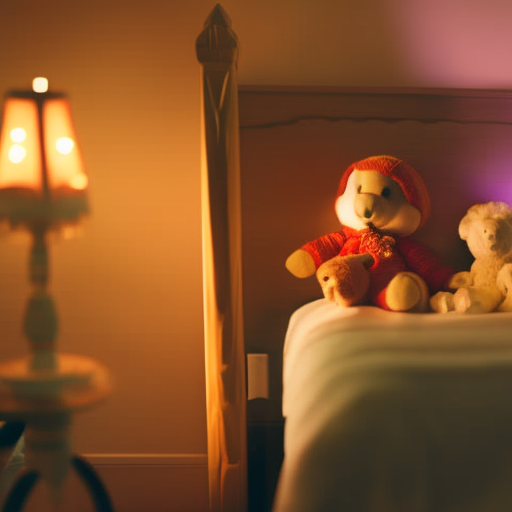"Cherishing Little Steps - A Haven for Baby and Family Journeys"
Nighttime Rituals for Toddlers
Are you tired of the bedtime struggle with your toddler?
It can feel like a never-ending battle to get them settled down and ready for sleep.
But fear not, there is hope!
By implementing some nighttime rituals, you can create a soothing and predictable routine that will help your little one wind down and drift off to dreamland.
So, what are these magical rituals, you ask?
Well, let’s dive in and discover the secrets to a peaceful bedtime routine for your toddler.
Key Takeaways
- Establishing a consistent bedtime routine helps toddlers develop a sense of security and predictability.
- Nighttime rituals signal to toddlers that it is time to wind down and prepare for sleep.
- Research shows that a regular bedtime routine can improve sleep quality and duration in toddlers.
- Nighttime rituals create a special bonding time between parents and toddlers.
Establish a Consistent Bedtime Routine

To ensure a smooth transition from playtime to bedtime, it’s essential to establish a consistent bedtime routine for your toddler. By establishing sleep schedules and following a regular routine, you can create a sense of predictability and security for your little one.
The benefits of a consistent bedtime routine are numerous.
Firstly, having a set routine helps signal to your toddler that it’s time to wind down and prepare for sleep. This can be particularly helpful for energetic and active toddlers who may struggle to settle down. By engaging in calming activities such as reading a story, taking a warm bath, or listening to soft music, you can help your child relax and transition into a more peaceful state.
Additionally, a consistent bedtime routine can help regulate your toddler’s internal body clock, making it easier for them to fall asleep and stay asleep throughout the night. When we follow the same routine every night, our bodies learn to associate these activities with sleep, making it easier for us to drift off and stay asleep.
Furthermore, a bedtime routine can create a sense of closeness and intimacy between you and your toddler. By spending quality time together before bed, you can strengthen your bond and create cherished memories. This is an opportunity for you to connect with your child, listen to their thoughts and concerns, and provide comfort and reassurance.
Start With a Soothing Bath

Prepare your toddler for a restful night’s sleep by starting their bedtime routine with a soothing bath. A warm bath can help relax your little one’s body and mind, making it easier for them to wind down and fall asleep. When it comes to bath time, there are a few things to keep in mind to ensure a soothing experience for your toddler.
First, choose scented bath products that are gentle on their delicate skin. Look for products that are specifically designed for toddlers, as they’re usually free of harsh chemicals and fragrances that can irritate their skin. Lavender or chamomile scents can be particularly calming and promote relaxation.
Next, pay attention to the water temperature. It should be warm, but not too hot. Test the water with your elbow or the inside of your wrist to make sure it’s comfortable for your toddler. Remember, their skin is more sensitive than yours, so what may feel warm to you could be too hot for them.
During bath time, engage in soothing activities such as gentle massage or singing soft lullabies. This can further relax your toddler and create a peaceful bedtime environment. Keep the lights dim and the atmosphere quiet, allowing your little one to slowly transition from playtime to bedtime.
Put on Comfortable Pajamas

After a soothing bath, the next step in your toddler’s bedtime routine is to slip them into comfortable pajamas. Choosing the right sleepwear for your little one is crucial to ensuring a peaceful night’s sleep. Nighttime rituals play a significant role in helping toddlers wind down and prepare for bed, and wearing cozy pajamas is an essential part of that routine.
When selecting toddler sleepwear, opt for soft, breathable fabrics like cotton or bamboo. These materials are gentle on your child’s delicate skin and allow for better air circulation, preventing overheating during the night. It’s also important to consider the weather and temperature in your child’s room. A lightweight, short-sleeved pajama set is ideal for warmer nights, while a long-sleeved, footed onesie provides extra warmth during colder months.
To help you visualize the various options, here’s a helpful table showcasing popular toddler sleepwear styles:
| Style | Description |
|---|---|
| Two-Piece Set | Consists of a top and matching shorts or pants |
| Onesie | Full-body pajamas with buttons or a zipper |
| Nightgown | Loose-fitting dress-like sleepwear |
Dim the Lights in the Bedroom

Dimming the lights in your toddler’s bedroom is a simple but effective way to create a calming and sleep-inducing environment. The right bedroom lighting can make a significant difference in your child’s ability to relax and drift off to dreamland.
Here are three reasons why you should consider dimming the lights in your toddler’s sleep environment:
-
Promotes relaxation: Soft, dim lighting signals to your toddler’s brain that it’s time to wind down and prepare for sleep. It helps create a soothing atmosphere that encourages relaxation and tranquility.
-
Reduces stimulation: Bright lights can be stimulating and make it harder for your little one to settle down. By dimming the lights, you’re minimizing distractions and creating a peaceful environment that supports better sleep.
-
Encourages melatonin production: Melatonin is a hormone that helps regulate sleep-wake cycles. The production of melatonin increases in response to darkness. By dimming the lights, you’re signaling to your toddler’s body that it’s time to produce this sleep-inducing hormone.
Creating the right sleep environment is crucial for your toddler’s well-being. Dimming the lights in their bedroom is a small but impactful step toward fostering a calm and restful atmosphere that promotes healthy sleep habits.
Read a Bedtime Story

To create a soothing bedtime routine for your toddler, indulge in the magical world of storytelling. Bedtime stories not only promote a sense of calm and security but also foster a love for reading from an early age. But how do you choose the perfect bedtime story for your little one?
The key is to consider their interests and age-appropriateness. Opt for books with vibrant illustrations and simple, repetitive text for younger toddlers, while older ones might enjoy stories with more complex plots and characters. Take into account their current fascinations, whether it’s dinosaurs, princesses, or animals, and select stories that align with those themes.
Once you’ve found the ideal story, make it an interactive experience for your toddler. Engage them by asking questions about the characters or the plot. Encourage them to predict what might happen next or even let them take turns in narrating parts of the story. Use different voices for the characters to make it more engaging and entertaining. You can also use props or puppets to bring the story to life.
Let your toddler’s imagination soar as they immerse themselves in the enchanting world of storytelling.
Sing a Lullaby

As you wrap up the bedtime story and prepare to settle your toddler into a peaceful slumber, why not add an extra touch of tranquility to the nighttime routine by singing a lullaby? Singing a lullaby to your little one not only creates a soothing atmosphere but also has numerous benefits for their well-being.
Here are three reasons why incorporating a lullaby into your toddler’s bedtime routine can be beneficial:
-
Music therapy: Singing a lullaby has been shown to have a calming effect on both children and adults. The gentle melody and rhythmic patterns can help to relax your toddler’s mind and body, making it easier for them to fall asleep.
-
Sleep associations: Creating a consistent bedtime routine helps to establish sleep associations in your toddler’s mind. When they hear the familiar lullaby, their brain recognizes it as a cue for sleep, signaling their body to wind down and prepare for rest.
-
Bonding time: Singing a lullaby to your toddler provides an intimate moment of connection between you and your child. The soft, melodic tones of your voice create a sense of security and comfort, fostering a deeper bond between you both.
Give a Goodnight Kiss and Hug

Give your toddler a warm and loving goodnight kiss and hug to create a comforting end to their bedtime routine. Bedtime cuddles aren’t just a sweet way to end the day; they also play a crucial role in your child’s overall well-being.
Establishing a bedtime routine is important for toddlers as it helps them relax, feel secure, and prepare for a restful night’s sleep.
When you give your toddler a goodnight kiss and hug, you aren’t only expressing your love for them but also providing them with a sense of comfort and security. Physical affection releases oxytocin, a hormone that promotes feelings of love and bonding, making your toddler feel safe and loved. This nightly ritual can also help regulate their emotions, reducing any anxiety or stress they may be feeling.
Incorporating bedtime cuddles into your toddler’s routine can have long-lasting benefits. It strengthens the parent-child bond and fosters a sense of trust and security. It also helps your child develop a positive association with bedtime, making it a more pleasant experience for both of you.
Create a Calm and Quiet Environment

After giving your toddler a warm and loving goodnight kiss and hug, it’s important to create a calm and quiet environment to help them transition into a peaceful night’s sleep. As the day winds down and bedtime approaches, here are some simple yet effective ways to create a soothing atmosphere for your little one:
-
Dim the lights: Lowering the intensity of the lights in your toddler’s bedroom signals to their brain that it’s time to relax and unwind. Consider using a nightlight or a dimmer switch to create a soft and gentle glow.
-
Establish a calming bedtime routine: Consistency is key when it comes to helping your toddler wind down. Establish a routine that includes activities like reading a bedtime story, taking a warm bath, or cuddling together. This predictable sequence of events will signal to your child that it’s time to relax and prepare for sleep.
-
Incorporate soft music: Music has a powerful effect on our emotions, and the right kind of music can help lull your toddler into a peaceful slumber. Choose soft and soothing melodies, such as lullabies or gentle instrumental tunes, to create a serene ambiance in their room.
Use a Nightlight for Comfort

To provide a sense of comfort and security, incorporating a nightlight into your toddler’s bedtime routine can make all the difference. Nightlights have numerous benefits that can help your little one feel safe and at ease during the nighttime hours.
One of the main advantages of using a nightlight is that it provides a soft and gentle glow in the room, which can help alleviate any fears of darkness that your toddler may have. This can create a soothing environment that promotes relaxation and better sleep.
In addition to the comfort it provides, a nightlight can also serve as a helpful tool for nighttime feedings or diaper changes. By keeping the room dimly lit, you can attend to your toddler’s needs without fully waking them up or disturbing their sleep patterns. This can make nighttime routines smoother and less disruptive for both you and your child.
However, if you prefer not to use a nightlight, there are alternative options to consider. You could use a small, portable nightlight that your toddler can carry with them if they need to get up during the night. Another alternative is to use a plug-in nightlight with an adjustable brightness setting, allowing you to control the level of light in the room.
Ultimately, the decision to use a nightlight or explore alternatives is a personal one that depends on your toddler’s individual needs and preferences. By considering the benefits and alternatives, you can choose the option that best suits your child’s comfort and helps them feel secure during their nighttime routine.
Practice Relaxation Techniques

As you create a soothing environment for your toddler’s bedtime routine by incorporating a nightlight, you can further enhance their relaxation and promote better sleep through the practice of relaxation techniques.
These techniques can help calm your little one’s mind and body, preparing them for a peaceful night’s rest. Here are three effective relaxation techniques that can serve as sleep aids for your toddler:
-
Deep Breathing Exercises: Teach your child to take slow, deep breaths in and out. Encourage them to imagine inhaling calmness and exhaling any tension or worries. Deep breathing can help relax their muscles and release any negative energy.
-
Progressive Muscle Relaxation: Guide your toddler through a muscle relaxation exercise. Ask them to tense and then release each muscle group in their body, starting from their toes and working their way up to their head. This technique helps relieve physical tension and promotes overall relaxation.
-
Bedtime Stories and Lullabies: Reading a soothing bedtime story or singing a gentle lullaby can create a tranquil atmosphere and help your toddler unwind. Choose stories and songs that have a calming effect, and make it a special ritual by cuddling up together.
Encourage Deep Breathing Exercises
To encourage deep breathing exercises, guide your toddler in taking slow, calming breaths while imagining inhaling tranquility and exhaling any tension or worries. Deep breathing has numerous benefits for both children and adults. It helps to calm the mind and body, reduce stress and anxiety, improve sleep quality, and enhance overall well-being. Teaching your toddler deep breathing techniques can be a valuable tool in their bedtime routine, promoting relaxation and preparing them for a restful night’s sleep.
Here are some calming techniques you can use to encourage deep breathing exercises:
| Technique | Description |
|---|---|
| Belly Breathing | Place your hand on your toddler’s tummy and ask them to take slow breaths, filling their belly. |
| 5-4-3-2-1 Counting | Guide your toddler to take a deep breath while counting to five, then exhale while counting to one. Repeat this process, gradually decreasing the count. |
| Imaginary Balloon | Encourage your child to imagine they are holding a balloon. Inhale deeply to fill the balloon, then exhale slowly to release the air. |
| Animal Breathing | Pretend to be different animals with your toddler, imitating their breathing patterns. For example, take slow, deep breaths like a turtle, or quick breaths like a bunny. |
Incorporating deep breathing exercises into your toddler’s nightly routine can have a profound impact on their overall well-being. By teaching them these calming techniques, you are providing them with valuable tools to manage stress and anxiety, leading to a more peaceful and restorative sleep.
Allow for a Transition Period Before Bedtime

To create a smooth bedtime routine for your toddler, it’s important to allow for a period of transition before settling down for the night. Transition activities can help your little one wind down and prepare their body and mind for sleep.
Here are some ideas to incorporate into your toddler’s nighttime ritual:
-
Reading a book: Choose a calming storybook to read together. This quiet activity can help your child relax and shift their focus from the busyness of the day to a more peaceful state.
-
Puzzles or quiet play: Engaging in quiet play or solving puzzles can help your toddler transition from the excitement of the day to a more relaxed state. This can be a great opportunity for them to practice problem-solving and fine motor skills.
-
Calming music: Playing soft and soothing music in the background can create a peaceful atmosphere in your toddler’s room. Consider lullabies or gentle instrumental melodies to help your little one unwind and drift off to sleep.
Frequently Asked Questions
How Often Should I Give My Toddler a Bath as Part of Their Nighttime Routine?
You should give your toddler a bath as part of their nighttime routine every few days. Incorporating bath time into their routine has many benefits, such as helping them relax and promoting better sleep.
Should I Dim the Lights in the Entire House or Just in the Bedroom?
Dimming the lights in the entire house or just the bedroom has its benefits and drawbacks. It creates a calm environment for sleep, but can also disrupt their natural sleep-wake cycle. Consider using a nightlight in the bedroom for a comforting glow.
Are There Specific Types of Bedtime Stories That Are More Effective in Helping My Toddler Fall Asleep?
There are different types of bedtime stories that can be more effective in helping your toddler fall asleep. Additionally, incorporating soothing music into a consistent bedtime routine can have added benefits for a calmer sleep.
How Long Should I Sing a Lullaby to My Toddler Before They Fall Asleep?
You should sing a lullaby to your toddler for as long as it takes for them to fall asleep. The duration can vary, but make sure it’s part of a consistent nighttime routine to help them relax and feel secure.
Are There Any Relaxation Techniques That Are Not Recommended for Toddlers Before Bedtime?
You want your toddler to have a calm bedtime routine. Some relaxation techniques may not be suitable for their age. Instead, focus on age-appropriate activities like reading a story or having a gentle massage.
Conclusion
In conclusion, by establishing a consistent bedtime routine, starting with a soothing bath, putting on comfortable pajamas, and dimming the lights, you can create a peaceful and calming atmosphere for your toddler’s nighttime rituals.
Reading a bedtime story, using a nightlight, practicing relaxation techniques, and encouraging deep breathing exercises are additional steps you can take to further enhance the bedtime routine.
By incorporating these elements into your toddler’s nighttime routine, you can help them transition to sleep more easily and ensure a restful night for both you and your little one.
Sweet dreams await!


